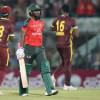Asia Cup or another India-Pakistan series in disguise?

There are three certainties in life: death, taxes, and India and Pakistan getting slotted in the same group in Asia Cup!
On Saturday, the Asian Cricket Council (ACC) announced the schedule of the forthcoming 17th edition of the continental tournament, and lo and behold, for the fourth straight edition, India and Pakistan were slotted in the same group.
The intention behind this move is simple, India-Pakistan clash draws more eyeballs than any other cricketing event and the more people tune in, the more cash there is to be made.
The fact that the two countries have not staged a bilateral series in over a decade and are in no position to hold one in the near future considering the rise in geo-political tension between the neighbours in recent years, makes this contest even more lucrative.
But how does the ACC ensure that these two teams get slotted in the same group every time? Simple, by bypassing the drawing ceremonies, which is usually how grouping is done for mega events in other sports, and drawing up the groups themselves, leaving nothing to chance.
Furthermore, the ACC has been particularly careful in ensuring that they can get a second serving of an India-Pakistan revenue pie in the Super Four stage by pitting them against significantly weaker sides in the group phase.
In the last three editions, the Asia Cup was a six-team affair, with two groups of three teams playing in the first round.
While in all three editions, three Test-playing nations in Bangladesh, Sri Lanka and Afghanistan were slotted together and fought for two available slots in the next stage, India and Pakistan had an easier path to the Super Four, being placed against Hong Kong in 2018 and 2022, and Nepal in 2023.
This year, the Asia Cup is an eight-team affair, as alongside the five Asian Test playing countries, hosts UAE, Oman and Hong Kong are set to compete.
And once again, Bangladesh, Sri Lanka and Afghanistan have been slotted together in Group B with new additions Hong Kong.
Meanwhile, Asian giants India and Pakistan were placed alongside Oman and the UAE in Group A.
With this design, ACC significantly raises the probability of India and Pakistan moving on to the next stage and clashing one more time.
What ACC and all financial stakeholders undoubtedly want and have been praying for in the last three editions is for the arch-rivals to qualify for the final, something that has never happened in Asia Cup.
So far though, it hasn't happened as India made it to the final and won in 2018 and 2023 while Pakistan reached it in 2022 and lost to Sri Lanka.
If both sides do qualify for the final, it would be their third clash in the tournament, which would mean the two sides would virtually complete a three-match bilateral series while competing in the Asia Cup.
The certainty of multiple India-Pakistan clashes is perhaps great for the advertisers and for the coffers of all involved in the Asia Cup, but this style of grouping is detrimental to the tournament itself.
The great thing about any multi-team tournament is nothing is for certain. Luck of the draw could pit Davids in front of Goliaths or create a clash of the titans in the preliminary stage of the competition.
This element of uncertainty adds to the appeal of any global sporting event, which has been missing in Asia Cup for some time.
Contradicting how this write up began, there was actually a time when India and Pakistan did not have to get pitted in the same group in the Asia Cup. It had happened in 2004, but at that time, the two countries used to regularly tour each other, so fans had their fill of the India-Pakistan rivalry and did not need it super-imposed.
The deteriorating relationship between the two nations since then has led to this current grouping system in the Asia Cup, which has turned the tournament into a pseudo India-Pakistan series, where two matches are almost certain and a third is on the cards.

 For all latest news, follow The Daily Star's Google News channel.
For all latest news, follow The Daily Star's Google News channel. 









Comments